Effect of Inonotus obliquus Extract Supplementation on Endurance Exercise and Energy-Consuming Processes through Lipid Transport in Mice
Abstract
1. Introduction
2. Materials and Methods
2.1. Animals and Experiment Design
2.2. Exercise Performance Test
2.3. Fatigue-Associated Biochemical Indices, Serum Biochemical Index, and Hormone Index
2.4. Tissue Glycogen Determination and Visceral Organ Weight
2.5. Magnetic Resonance Imaging
2.6. Measuring Energy Metabolism and In-Cage Spontaneous Physical Activity
2.7. RNA Sequencing of Muscle Tissue
2.8. Statistical Analysis
3. Results
3.1. Effect of Six-Week IO Supplementation on General Characteristics and MRI Analysis
3.2. Effect of Six-Week IO Supplementation on Exercise Performance
3.3. Effect of Six-Week IO Supplementation on the Acute Exercise Profile after a 15 Min Swimming Test
3.4. Effect of Six-Week IO Supplementation on Glycogen Content
3.5. Effect of Six-Week IO Supplementation on Energy Metabolism
3.6. Effect of Six-Week IO Supplementation on Biochemical Variables
3.7. Effect of Six-Week IO Supplementation on the Gene Ontology Analysis and Enrichment Analysis of the Kyoto Encyclopedia of Genes and Genomes in Muscle
4. Discussion
5. Conclusions
Supplementary Materials
Author Contributions
Funding
Institutional Review Board Statement
Informed Consent Statement
Data Availability Statement
Acknowledgments
Conflicts of Interest
References
- Balandaykin, M.E.; Zmitrovich, I.V. Review on Chaga Medicinal Mushroom, Inonotus obliquus (Higher Basidiomycetes): Realm of Medicinal Applications and Approaches on Estimating its Resource Potential. Int. J. Med. Mushrooms 2015, 17, 95–104. [Google Scholar] [CrossRef] [PubMed]
- Song, F.Q.; Liu, Y.; Kong, X.S.; Chang, W.; Song, G. Progress on understanding the anticancer mechanisms of medicinal mushroom: Inonotus obliquus. Asian Pac. J. Cancer Prev. APJCP 2013, 14, 1571–1578. [Google Scholar] [CrossRef] [PubMed]
- Hwang, B.S.; Lee, I.K.; Yun, B.S. Phenolic compounds from the fungus Inonotus obliquus and their antioxidant properties. J. Antibiot. 2016, 69, 108–110. [Google Scholar] [CrossRef]
- Wold, C.W.; Kjeldsen, C.; Corthay, A.; Rise, F.; Christensen, B.E.; Duus, J.; Inngjerdingen, K.T. Structural characterization of bioactive heteropolysaccharides from the medicinal fungus Inonotus obliquus (Chaga). Carbohydr. Polym. 2018, 185, 27–40. [Google Scholar] [CrossRef]
- Wang, L.X.; Lu, Z.M.; Geng, Y.; Zhang, X.M.; Xu, G.H.; Shi, J.S.; Xu, Z.H. Stimulated production of steroids in Inonotus obliquus by host factors from birch. J. Biosci. Bioeng. 2014, 118, 728–731. [Google Scholar] [CrossRef]
- Nikitina, S.A.; Khabibrakhmanova, V.R.; Sysoeva, M.A. Composition and biological activity of triterpenes and steroids from Inonotus obliquus (chaga). Biomeditsinskaia Khimiia 2016, 62, 369–375. [Google Scholar] [CrossRef] [PubMed]
- Wang, C.; Chen, Z.; Pan, Y.; Gao, X.; Chen, H. Anti-diabetic effects of Inonotus obliquus polysaccharides-chromium (III) complex in type 2 diabetic mice and its sub-acute toxicity evaluation in normal mice. Food Chem. Toxicol. 2017, 108, 498–509. [Google Scholar] [CrossRef] [PubMed]
- Wang, J.; Hu, W.; Li, L.; Huang, X.; Liu, Y.; Wang, D.; Teng, L. Antidiabetic activities of polysaccharides separated from Inonotus obliquus via the modulation of oxidative stress in mice with streptozotocin-induced diabetes. PLoS ONE 2017, 12, e0180476. [Google Scholar] [CrossRef] [PubMed]
- Lee, J.H.; Hyun, C.K. Insulin-sensitizing and beneficial lipid-metabolic effects of the water-soluble melanin complex extracted from Inonotus obliquus. Phytother. Res. 2014, 28, 1320–1328. [Google Scholar] [CrossRef] [PubMed]
- Kim, J.C. The effect of exercise training combined with PPARγ agonist on skeletal muscle glucose uptake and insulin sensitivity in induced diabetic obese Zucker rats. J. Exerc. Nutr. Biochem. 2016, 20, 42–50. [Google Scholar] [CrossRef]
- Yue, Z.; Xiuhong, Z.; Shuyan, Y.; Zhonghua, Z. Effect of Inonotus Obliquus Polysaccharides on physical fatigue in mice. J. Tradit. Chin. Med. 2015, 35, 468–472. [Google Scholar] [PubMed]
- Yang, M.; Hu, D.; Cui, Z.; Li, H.; Man, C.; Jiang, Y. Lipid-Lowering Effects of Inonotus obliquus Polysaccharide In Vivo and In Vitro. Foods 2021, 10, 3085. [Google Scholar] [CrossRef] [PubMed]
- Wang, J.; Wang, C.; Li, S.; Li, W.; Yuan, G.; Pan, Y.; Chen, H. Anti-diabetic effects of Inonotus obliquus polysaccharides in streptozotocin-induced type 2 diabetic mice and potential mechanism via PI3K-Akt signal pathway. Biomed. Pharmacother. 2017, 95, 1669–1677. [Google Scholar] [CrossRef] [PubMed]
- Corcoran, M.P.; Lamon-Fava, S.; Fielding, R.A. Skeletal muscle lipid deposition and insulin resistance: Effect of dietary fatty acids and exercise. Am. J. Clin. Nutr. 2007, 85, 662–677. [Google Scholar] [PubMed]
- Kim, J.; Yang, S.C.; Hwang, A.Y.; Cho, H.; Hwang, K.T. Composition of Triterpenoids in Inonotus obliquus and Their Anti-Proliferative Activity on Cancer Cell Lines. Molecules 2020, 25, 4066. [Google Scholar] [CrossRef] [PubMed]
- Huang, C.C.; Hsu, M.C.; Huang, W.C.; Yang, H.R.; Hou, C.C. Triterpenoid-Rich Extract from Antrodia camphorata Improves Physical Fatigue and Exercise Performance in Mice. Evid. Based Complement. Altern. Med. 2012, 2012, 364741. [Google Scholar] [CrossRef]
- Ament, W.; Verkerke, G.J.J. Exercise and fatigue. Sport. Med. 2009, 39, 389–422. [Google Scholar] [CrossRef] [PubMed]
- Chen, Y.-M.; Wei, L.; Chiu, Y.-S.; Hsu, Y.-J.; Tsai, T.-Y.; Wang, M.-F.; Huang, C.-C. Lactobacillus plantarum TWK10 supplementation improves exercise performance and increases muscle mass in mice. Nutrients 2016, 8, 205. [Google Scholar] [CrossRef] [PubMed]
- Duru, K.C.; Kovaleva, E.G.; Danilova, I.G.; van der Bijl, P. The pharmacological potential and possible molecular mechanisms of action of Inonotus obliquus from preclinical studies. Phytother. Res. 2019, 33, 1966–1980. [Google Scholar] [CrossRef]
- Castro, B.; Kuang, S. Evaluation of Muscle Performance in Mice by Treadmill Exhaustion Test and Whole-limb Grip Strength Assay. Bio. Protoc. 2017, 7, e2237. [Google Scholar] [CrossRef]
- Chen, Y.M.; Chiu, W.C.; Chiu, Y.S.; Li, T.; Sung, H.C.; Hsiao, C.Y. Supplementation of nano-bubble curcumin extract improves gut microbiota composition and exercise performance in mice. Food Funct. 2020, 11, 3574–3584. [Google Scholar] [CrossRef] [PubMed]
- Lighton, J.R. Limitations and requirements for measuring metabolic rates: A mini review. Eur. J. Clin. Nutr. 2017, 71, 301–305. [Google Scholar] [CrossRef] [PubMed]
- Vu, J.P.; Luong, L.; Parsons, W.F.; Oh, S.; Sanford, D.; Gabalski, A.; Lighton, J.R.; Pisegna, J.R.; Germano, P.M. Long-Term Intake of a High-Protein Diet Affects Body Phenotype, Metabolism, and Plasma Hormones in Mice. J. Nutr. 2017, 147, 2243–2251. [Google Scholar] [CrossRef] [PubMed]
- Mazur-Bialy, A.I.; Bilski, J.; Wojcik, D.; Brzozowski, B.; Surmiak, M.; Hubalewska-Mazgaj, M.; Chmura, A.; Magierowski, M.; Magierowska, K.; Mach, T.; et al. Beneficial Effect of Voluntary Exercise on Experimental Colitis in Mice Fed a High-Fat Diet: The Role of Irisin, Adiponectin and Proinflammatory Biomarkers. Nutrients 2017, 9, 410. [Google Scholar] [CrossRef] [PubMed]
- Kimber, N.E.; Heigenhauser, G.J.; Spriet, L.L.; Dyck, D.J. Skeletal muscle fat and carbohydrate metabolism during recovery from glycogen-depleting exercise in humans. J. Physiol. 2003, 548, 919–927. [Google Scholar] [CrossRef] [PubMed]
- Lin, Y.; Yang, J.; He, D.; Li, X.; Li, J.; Tang, Y.; Diao, Y. Differently Expression Analysis and Function Prediction of Long Non-coding RNAs in Duck Embryo Fibroblast Cells Infected by Duck Tembusu Virus. Front. Immunol. 2020, 11, 1729. [Google Scholar] [CrossRef] [PubMed]
- Love, M.I.; Huber, W.; Anders, S. Moderated estimation of fold change and dispersion for RNA-seq data with DESeq2. Genome Biol. 2014, 15, 550. [Google Scholar] [CrossRef] [PubMed]
- Young, M.D.; Wakefield, M.J.; Smyth, G.K.; Oshlack, A. Gene ontology analysis for RNA-seq: Accounting for selection bias. Genome Biol. 2010, 11, R14. [Google Scholar] [CrossRef] [PubMed]
- Luo, W.; Friedman, M.S.; Shedden, K.; Hankenson, K.D.; Woolf, P.J. GAGE: Generally applicable gene set enrichment for pathway analysis. BMC Bioinform. 2009, 10, 161. [Google Scholar] [CrossRef]
- Longo, K.A.; Charoenthongtrakul, S.; Giuliana, D.J.; Govek, E.K.; McDonagh, T.; Distefano, P.S.; Geddes, B.J. The 24-hour respiratory quotient predicts energy intake and changes in body mass. Am. J. Physiol. Regul. Integr. Comp. Physiol. 2010, 298, R747–R754. [Google Scholar] [CrossRef] [PubMed]
- Arha, D.; Ramakrishna, E.; Gupta, A.P.; Rai, A.K.; Sharma, A.; Ahmad, I.; Riyazuddin, M.; Gayen, J.R.; Maurya, R.; Tamrakar, A.K. Isoalantolactone derivative promotes glucose utilization in skeletal muscle cells and increases energy expenditure in db/db mice via activating AMPK-dependent signaling. Mol. Cell. Endocrinol. 2018, 460, 134–151. [Google Scholar] [CrossRef] [PubMed]
- Zhang, C.J.; Guo, J.Y.; Cheng, H.; Li, L.; Liu, Y.; Shi, Y.; Xu, J.; Yu, H.T. Spatial structure and anti-fatigue of polysaccharide from Inonotus obliquus. Int. J. Biol. Macromol. 2020, 151, 855–860. [Google Scholar] [CrossRef] [PubMed]
- Lenhart, K.C.; O’Neill, T.J.t.; Cheng, Z.; Dee, R.; Demonbreun, A.R.; Li, J.; Xiao, X.; McNally, E.M.; Mack, C.P.; Taylor, J.M. GRAF1 deficiency blunts sarcolemmal injury repair and exacerbates cardiac and skeletal muscle pathology in dystrophin-deficient mice. Skelet Muscle 2015, 5, 27. [Google Scholar] [CrossRef] [PubMed]
- Burke, L.M.; Whitfield, J.; Heikura, I.A.; Ross, M.L.R.; Tee, N.; Forbes, S.F.; Hall, R.; McKay, A.K.A.; Wallett, A.M.; Sharma, A.P. Adaptation to a low carbohydrate high fat diet is rapid but impairs endurance exercise metabolism and performance despite enhanced glycogen availability. J. Physiol. 2021, 599, 771–790. [Google Scholar] [CrossRef] [PubMed]
- Dos Reis, F.A.; da Silva, B.A.; Laraia, E.M.; de Melo, R.M.; Silva, P.H.; Leal-Junior, E.C.; de Carvalho Pde, T. Effects of pre- or post-exercise low-level laser therapy (830 nm) on skeletal muscle fatigue and biochemical markers of recovery in humans: Double-blind placebo-controlled trial. Photomed. Laser Surg. 2014, 32, 106–112. [Google Scholar] [CrossRef]
- Chou, Y.J.; Kan, W.C.; Chang, C.M.; Peng, Y.J.; Wang, H.Y.; Yu, W.C.; Cheng, Y.H.; Jhang, Y.R.; Liu, H.W.; Chuu, J.J. Renal Protective Effects of Low Molecular Weight of Inonotus obliquus Polysaccharide (LIOP) on HFD/STZ-Induced Nephropathy in Mice. Int. J. Mol. Sci. 2016, 17, 1535. [Google Scholar] [CrossRef]
- Yang, S.; Yan, J.; Yang, L.; Meng, Y.; Wang, N.; He, C.; Fan, Y.; Zhou, Y. Alkali-soluble polysaccharides from mushroom fruiting bodies improve insulin resistance. Int. J. Biol. Macromol. 2019, 126, 466–474. [Google Scholar] [CrossRef]
- Egger, A.; Kreis, R.; Allemann, S.; Stettler, C.; Diem, P.; Buehler, T.; Boesch, C.; Christ, E.R. The effect of aerobic exercise on intrahepatocellular and intramyocellular lipids in healthy subjects. PLoS ONE 2013, 8, e70865. [Google Scholar] [CrossRef]
- Bilet, L.; Brouwers, B.; van Ewijk, P.A.; Hesselink, M.K.; Kooi, M.E.; Schrauwen, P.; Schrauwen-Hinderling, V.B. Acute exercise does not decrease liver fat in men with overweight or NAFLD. Sci. Rep. 2015, 5, 9709. [Google Scholar] [CrossRef]
- Schutz, Y. Abnormalities of fuel utilization as predisposing to the development of obesity in humans. Obes. Res. 1995, 3 (Suppl. S2), 173s–178s. [Google Scholar] [CrossRef] [PubMed]
- Xu, H.Y.; Sun, J.E.; Lu, Z.M.; Zhang, X.M.; Dou, W.F.; Xu, Z.H. Beneficial effects of the ethanol extract from the dry matter of a culture broth of Inonotus obliquus in submerged culture on the antioxidant defence system and regeneration of pancreatic beta-cells in experimental diabetes in mice. Nat. Prod. Res. 2010, 24, 542–553. [Google Scholar] [CrossRef] [PubMed]
- Carvalho, M.B.; Brandao, C.F.C.; Fassini, P.G.; Bianco, T.M.; Batitucci, G.; Galan, B.S.M.; De Carvalho, F.G.; Vieira, T.S.; Ferriolli, E.; Marchini, J.S.; et al. Taurine Supplementation Increases Post-Exercise Lipid Oxidation at Moderate Intensity in Fasted Healthy Males. Nutrients 2020, 12, 1540. [Google Scholar] [CrossRef] [PubMed]
- Weyer, C.; Pratley, R.E.; Salbe, A.D.; Bogardus, C.; Ravussin, E.; Tataranni, P.A. Energy expenditure, fat oxidation, and body weight regulation: A study of metabolic adaptation to long-term weight change. J. Clin. Endocrinol. Metab. 2000, 85, 1087–1094. [Google Scholar] [CrossRef] [PubMed]
- Leońska-Duniec, A.; Cięszczyk, P.; Ahmetov, I.I. Chapter Eleven—Genes and individual responsiveness to exercise-induced fat loss. In Sports, Exercise, and Nutritional Genomics; Barh, D., Ahmetov, I.I., Eds.; Academic Press: Cambridge, MA, USA, 2019; pp. 231–247. [Google Scholar]
- Wang, C.; Gao, X.; Santhanam, R.K.; Chen, Z.; Chen, Y.; Xu, L.; Wang, C.; Ferri, N.; Chen, H. Effects of polysaccharides from Inonotus obliquus and its chromium (III) complex on advanced glycation end-products formation, α-amylase, α-glucosidase activity and H2O2-induced oxidative damage in hepatic L02 cells. Food Chem. Toxicol. 2018, 116, 335–345. [Google Scholar] [CrossRef]
- Dressel, U.; Allen, T.L.; Pippal, J.B.; Rohde, P.R.; Lau, P.; Muscat, G.E. The peroxisome proliferator-activated receptor beta/delta agonist, GW501516, regulates the expression of genes involved in lipid catabolism and energy uncoupling in skeletal muscle cells. Mol. Endocrinol. 2003, 17, 2477–2493. [Google Scholar] [CrossRef]

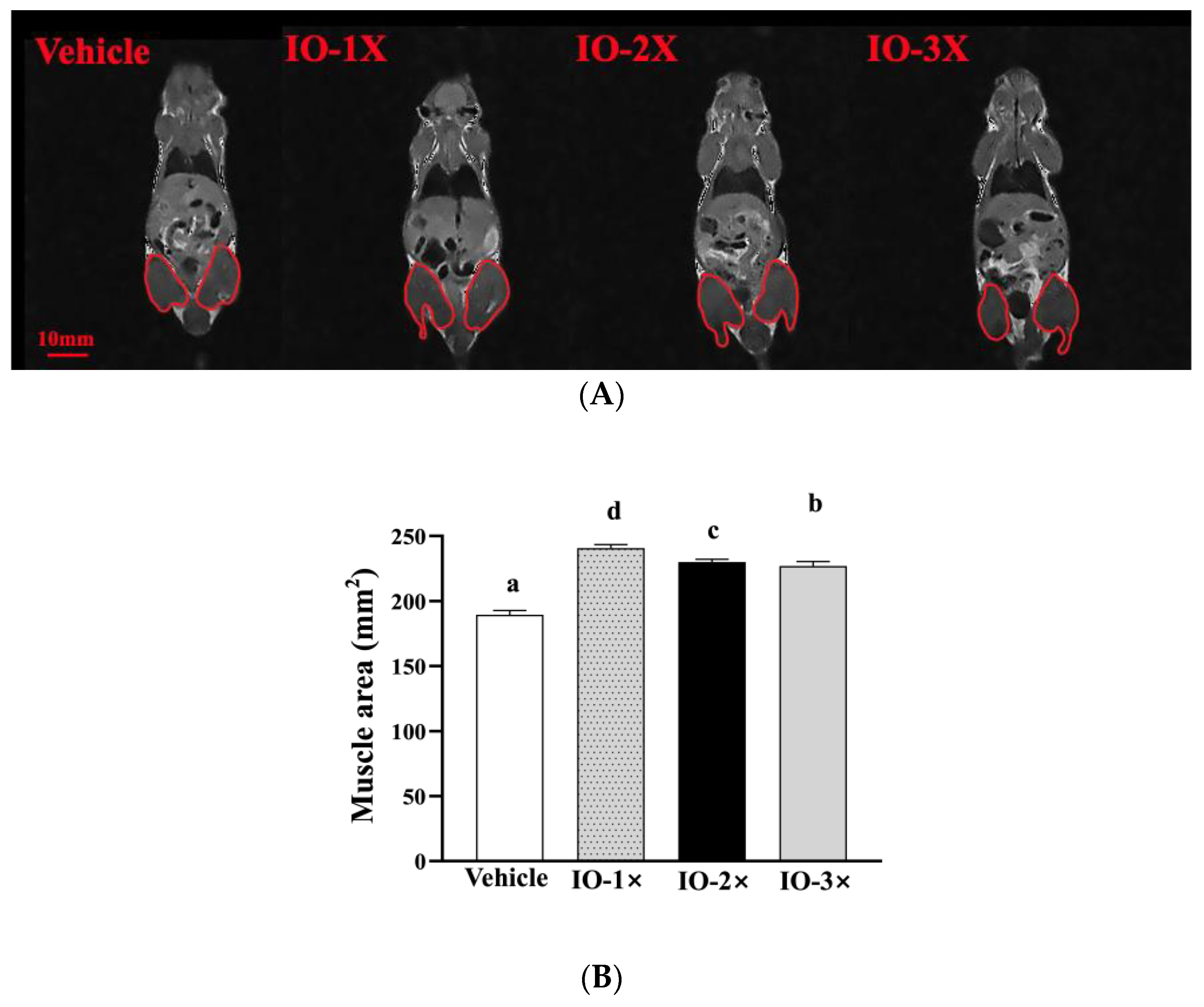
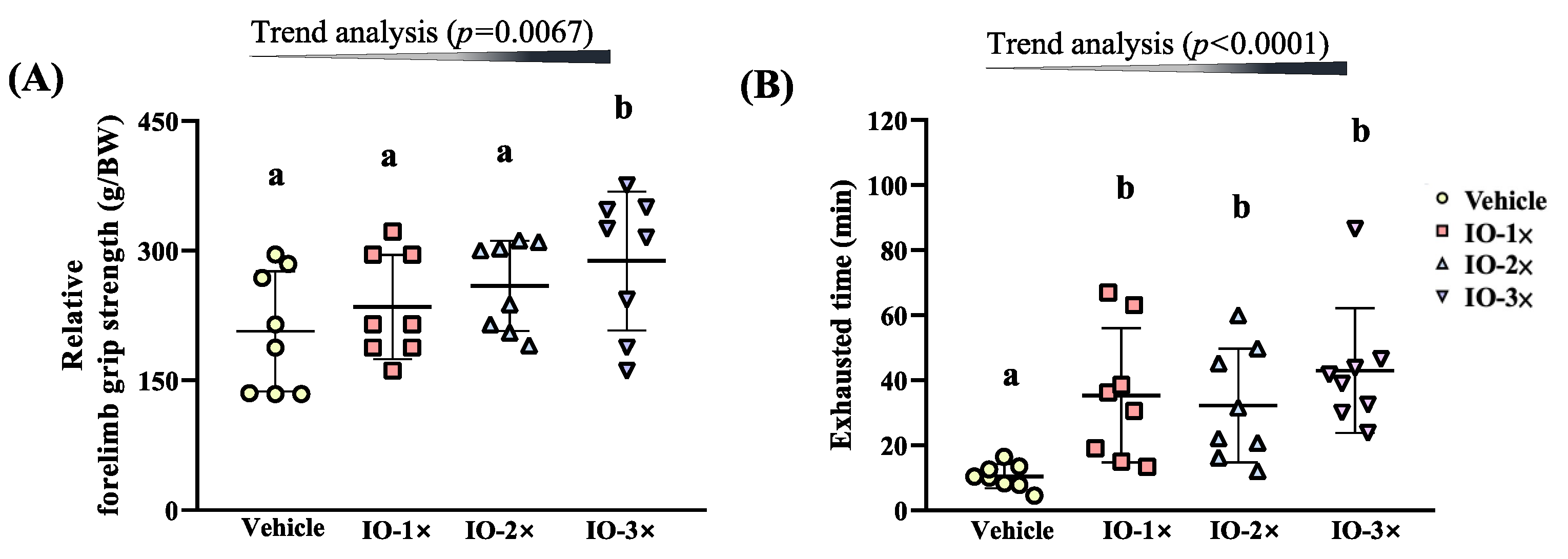
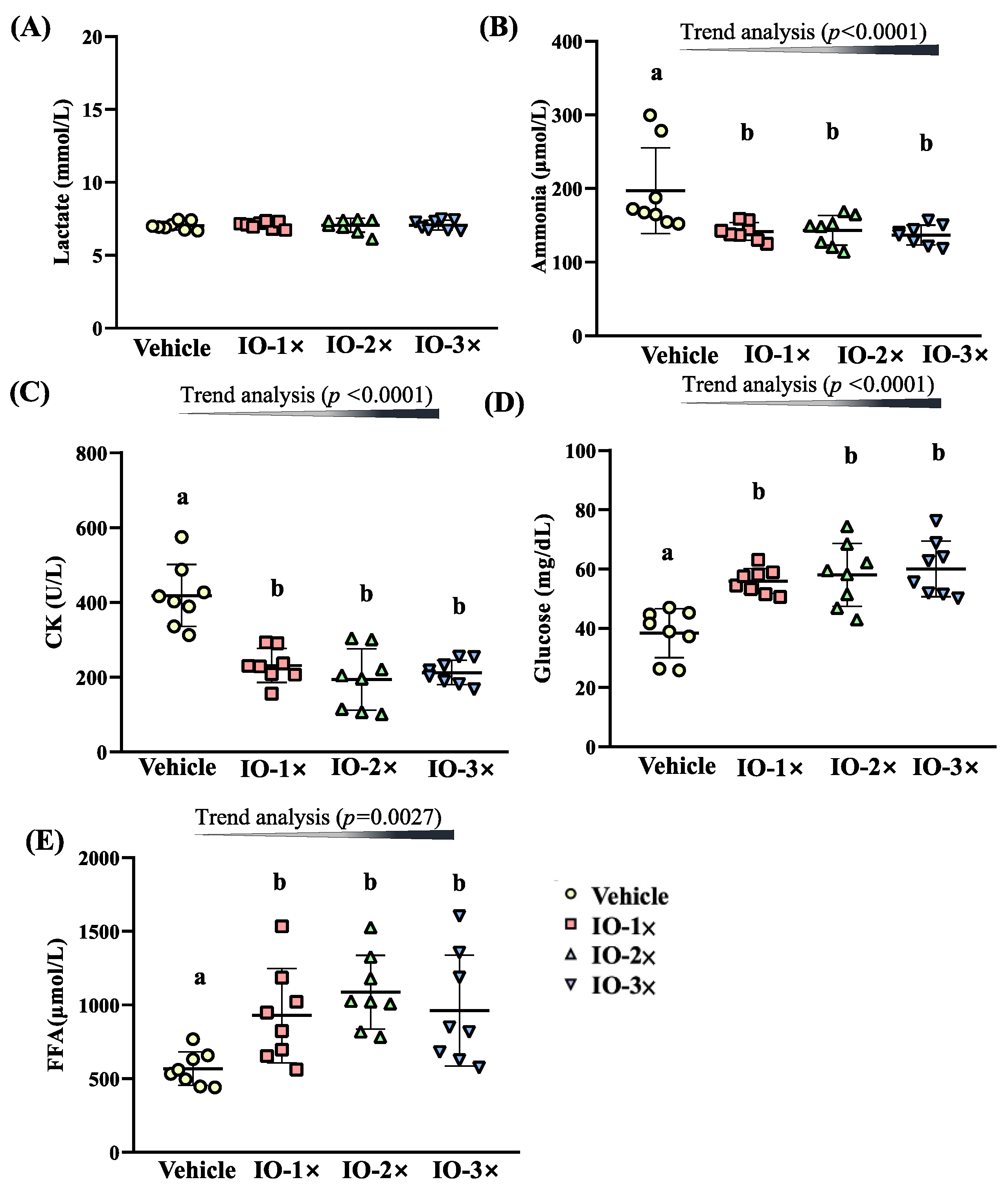
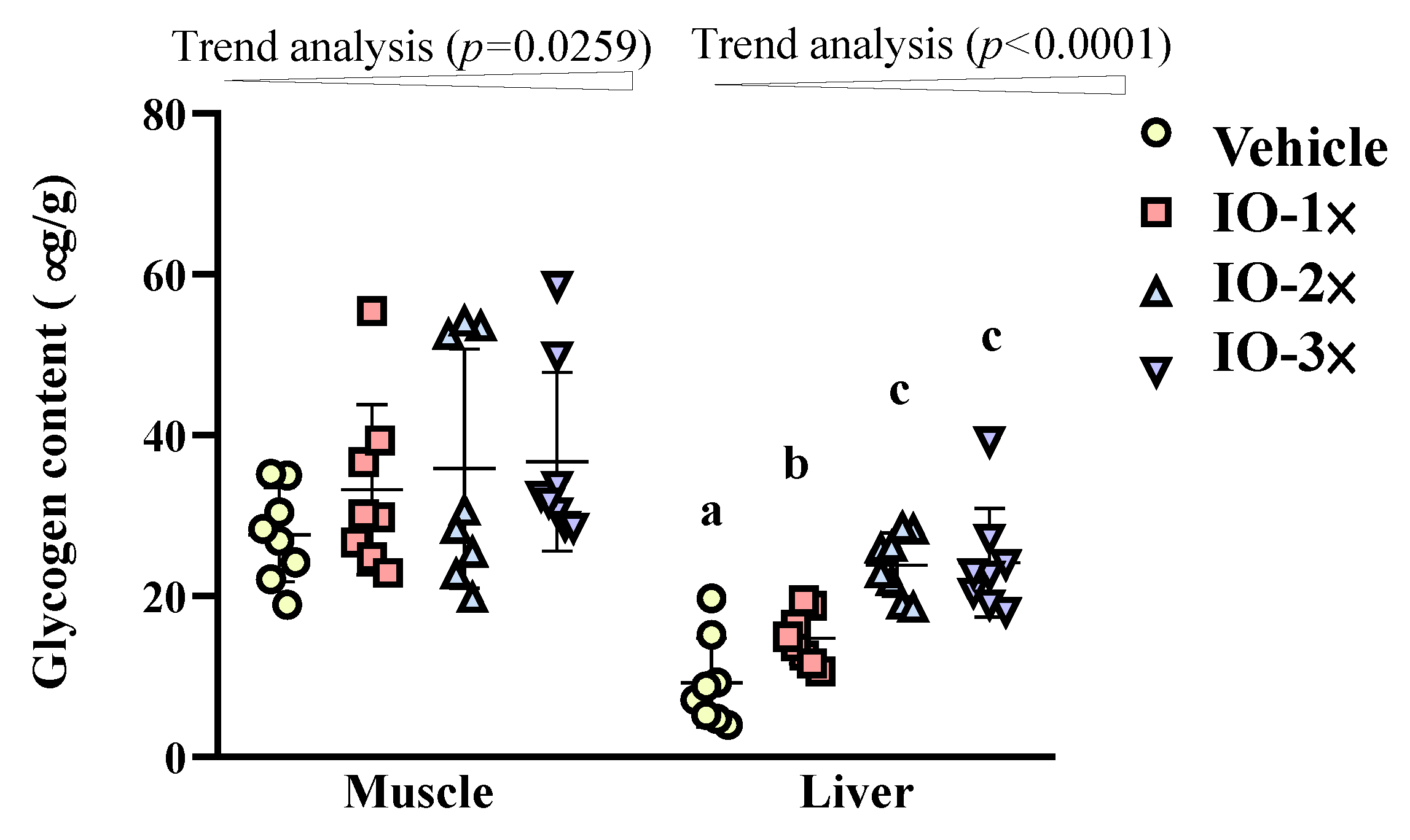
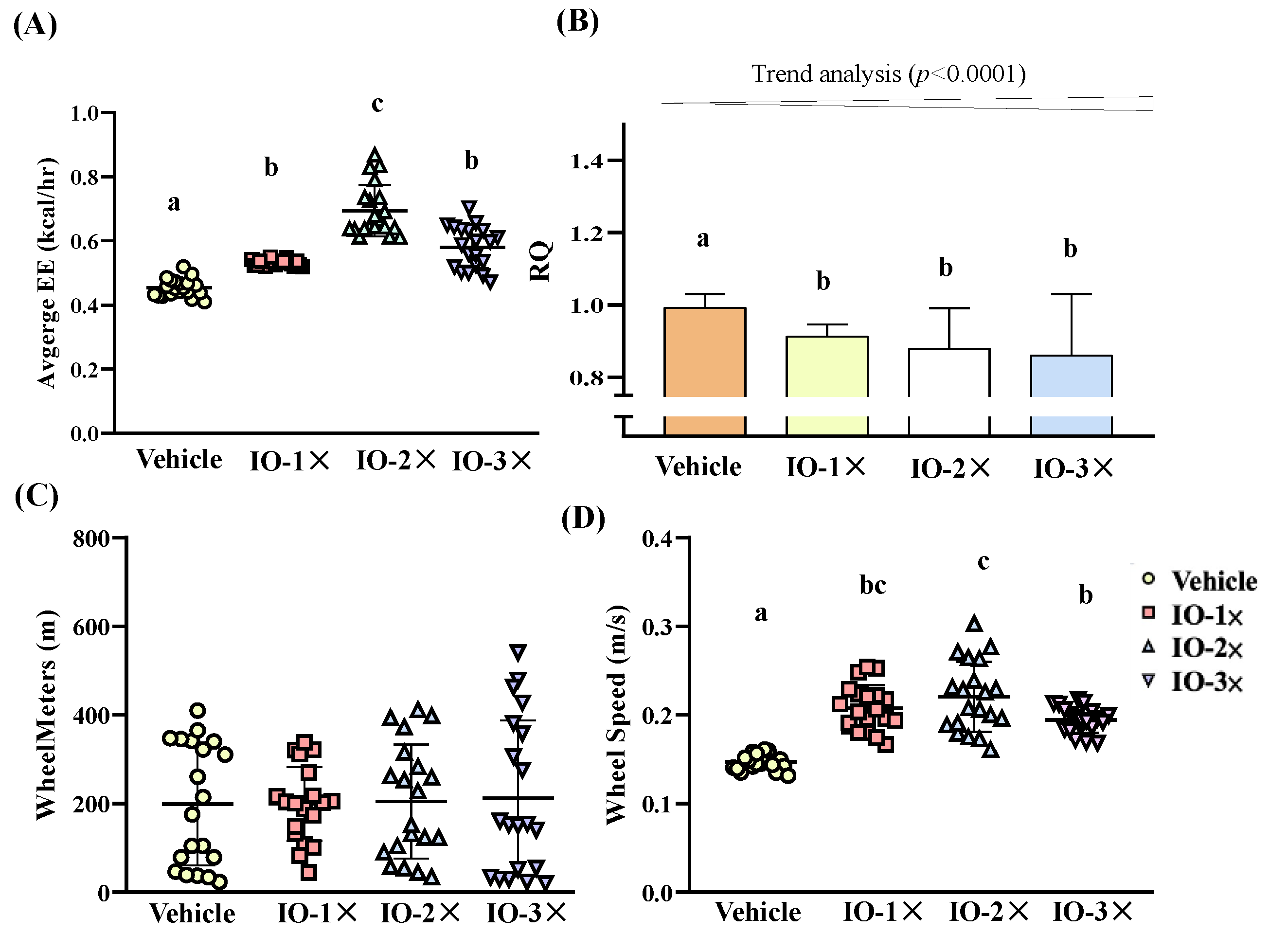
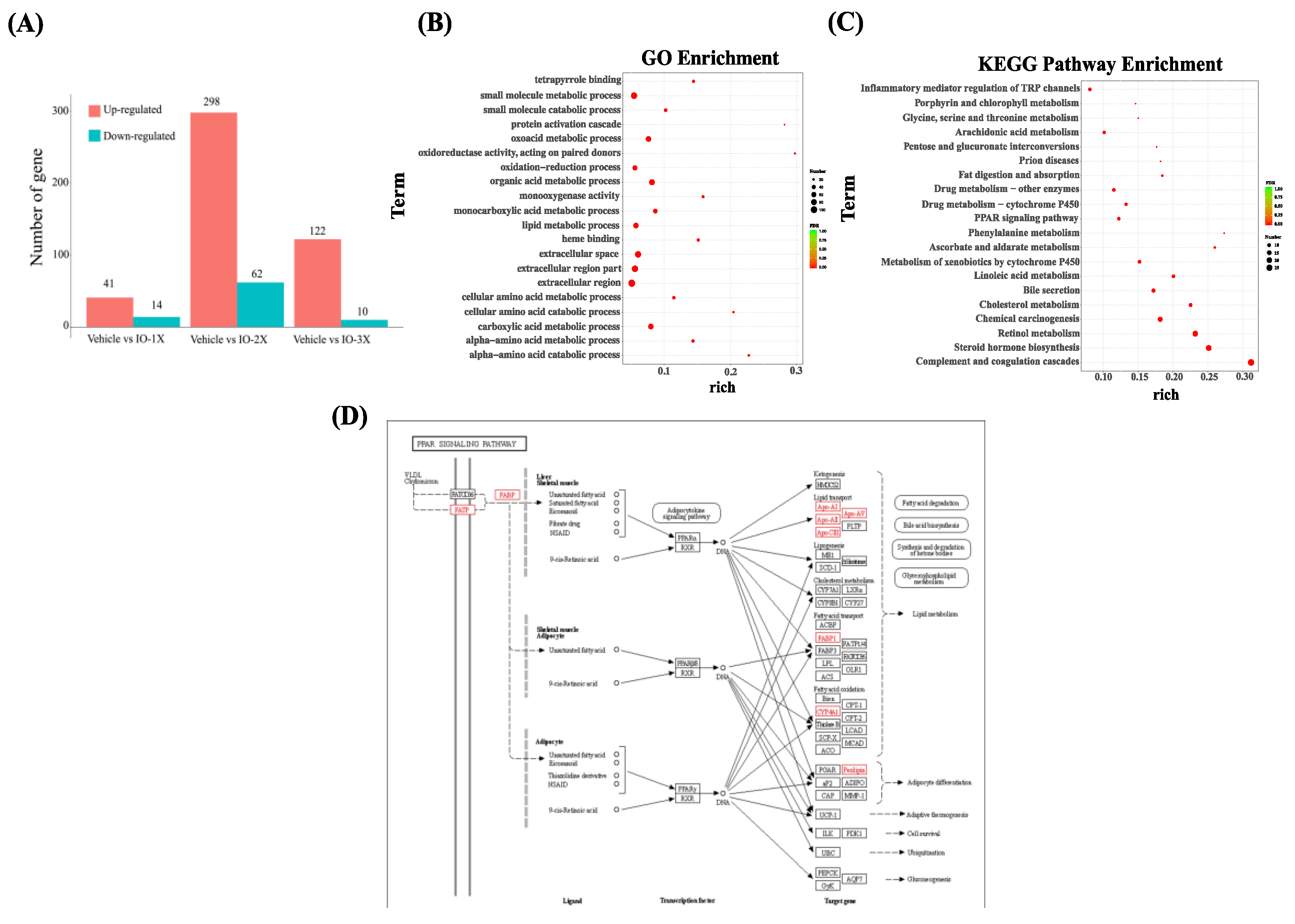
| Characteristic | Vehicle | IO-1 | IO-2 | IO-3 | Trend Analysis |
|---|---|---|---|---|---|
| Initial BW (g) | 33.25 ± 11.8 | 33.10 ± 11.7 | 33.28 ± 1.8 | 33.20 ± 11.7 | 0.8641 |
| Final BW (g) | 37.69 ± 13.3 | 37.89 ± 13.4 | 38.49 ± 13.6 | 38.63 ± 13.7 | 0.0968 |
| Food intake (g/day) | 4.99 ± 1.8 | 4.73 ± 1.7 | 4.84 ± 1.7 | 4.82 ± 1.7 | 0.5274 |
| Water intake (g/day) | 6.99 ± 2.5 | 6.81 ± 2.4 | 7.25 ± 2.6 | 7.04 ± 2.5 | 0.1163 |
| Liver (g) | 1.09 ± 0.4 | 1.03 ± 0.4 | 1.03 ± 0.4 | 1.03 ± 0.4 | 0.0848 |
| Lung (g) | 0.22 ± 0.1 | 0.21 ± 0.1 | 0.21 ± 0.1 | 0.21 ± 0.1 | 0.0699 |
| Heart (g) | 0.18 ± 0.1 | 0.18 ± 0.1 | 0.19 ± 0.1 | 0.19 ± 0.1 | 0.7387 |
| EFP (g) | 0.69 ± 0.2 a | 0.63 ± 0.2 ab | 0.57 ± 0.2 bc | 0.54 ± 0.2 c | <0.0001 |
| Muscle (g) | 0.40 ± 0.1 a | 0.44 ± 0.2 bc | 0.45 ± 0.2 c | 0.42 ± 0.1 ab | 0.5613 |
| BAT (g) | 0.17 ± 0.1 a | 0.21 ± 0.1 b | 0.20 ± 0.1 ab | 0.20 ± 0.1 ab | 0.4940 |
| Relative Liver weight (%) | 2.89 ± 1.0 | 2.72 ± 1.0 | 2.68 ± 0.9 | 2.66 ± 0.9 | 0.0159 |
| Relative Lung weight (%) | 6.77 ± 2.4 | 7.87 ± 2.8 | 7.81 ± 2.8 | 7.79 ± 2.8 | 0.4397 |
| Relative Heart weight (%) | 2.20 ± 0.8 | 2.30 ± 0.8 | 2.46 ± 0.9 | 2.39 ± 0.8 | 0.7175 |
| Relative EFP weight (%) | 3.91 ± 1.4 a | 3.31 ± 1.2 ab | 3.14 ± 1.1 ab | 3.10 ± 1.1 b | 0.0479 |
| Relative Muscle weight (%) | 14.84 ± 5.2 a | 19.41 ± 6.9 b | 18.98 ± 6.7 b | 17.57 ± 6.2 ab | 0.5518 |
| Relative BAT weight (%) | 3.51 ± 1.2 a | 6.39 ± 2.3 b | 6.57 ± 2.3 b | 6.48 ± 2.3 b | 0.0021 |
| Parameter | Vehicle | IO-1 | IO-2 | IO-3 | Trend Analysis |
|---|---|---|---|---|---|
| ALT (U/L) | 50.9 ± 18 | 51.3 ± 18.1 | 43.1 ± 15.2 | 47.3 ± 13.9 | 0.2698 |
| AST (U/L) | 114.8 ± 40.6 | 100.1 ± 35.4 | 99.9 ± 35.3 | 116.9 ± 41.3 | 0.6901 |
| TP (G/L) | 55.4 ± 19.6 | 57.6 ± 20.4 | 56.8 ± 20.1 | 57.6 ± 20.4 | 0.1849 |
| ALB (G/L) | 41.3 ± 14.6 a | 41.3 ± 14.6 a | 40.2 ± 14.2 ab | 39.1 ± 13.8 b | 0.0021 |
| BUN (mmol/L) | 8.3 ± 2.9 | 8.1 ± 2.9 | 8.2 ± 2.9 | 7.8 ± 2.8 | 0.1667 |
| CRE (μmol/L) | 39.6 ± 14 | 44.9 ± 15.9 | 48.6 ± 17.2 | 51.4 ± 18.2 | <0.0001 |
| UA (μmol/L) | 121.8 ± 43.1 | 115.5 ± 40.8 | 131.1 ± 46.4 | 122.6 ± 43.3 | 0.5636 |
| TC (mg/dL) | 179.2 ± 63.4 a | 136.2 ± 48.2 b | 131.1 ± 46.3 b | 130.4 ± 46.1 b | <0.0001 |
| TG (mg/dL) | 137.8 ± 48.7 a | 97.6 ± 34.5 b | 85.1 ± 30.1 b | 81.2 ± 28.7 b | <0.0001 |
| Glucose (mg/dL) | 82.9 ± 29.3 | 81 ± 28.7 | 81.5 ± 28.8 | 85.7 ± 30.3 | 0.6562 |
Publisher’s Note: MDPI stays neutral with regard to jurisdictional claims in published maps and institutional affiliations. |
© 2022 by the authors. Licensee MDPI, Basel, Switzerland. This article is an open access article distributed under the terms and conditions of the Creative Commons Attribution (CC BY) license (https://creativecommons.org/licenses/by/4.0/).
Share and Cite
Chen, Y.-M.; Chiu, W.-C.; Chiu, Y.-S. Effect of Inonotus obliquus Extract Supplementation on Endurance Exercise and Energy-Consuming Processes through Lipid Transport in Mice. Nutrients 2022, 14, 5007. https://doi.org/10.3390/nu14235007
Chen Y-M, Chiu W-C, Chiu Y-S. Effect of Inonotus obliquus Extract Supplementation on Endurance Exercise and Energy-Consuming Processes through Lipid Transport in Mice. Nutrients. 2022; 14(23):5007. https://doi.org/10.3390/nu14235007
Chicago/Turabian StyleChen, Yi-Ming, Wan-Chun Chiu, and Yen-Shuo Chiu. 2022. "Effect of Inonotus obliquus Extract Supplementation on Endurance Exercise and Energy-Consuming Processes through Lipid Transport in Mice" Nutrients 14, no. 23: 5007. https://doi.org/10.3390/nu14235007
APA StyleChen, Y.-M., Chiu, W.-C., & Chiu, Y.-S. (2022). Effect of Inonotus obliquus Extract Supplementation on Endurance Exercise and Energy-Consuming Processes through Lipid Transport in Mice. Nutrients, 14(23), 5007. https://doi.org/10.3390/nu14235007







